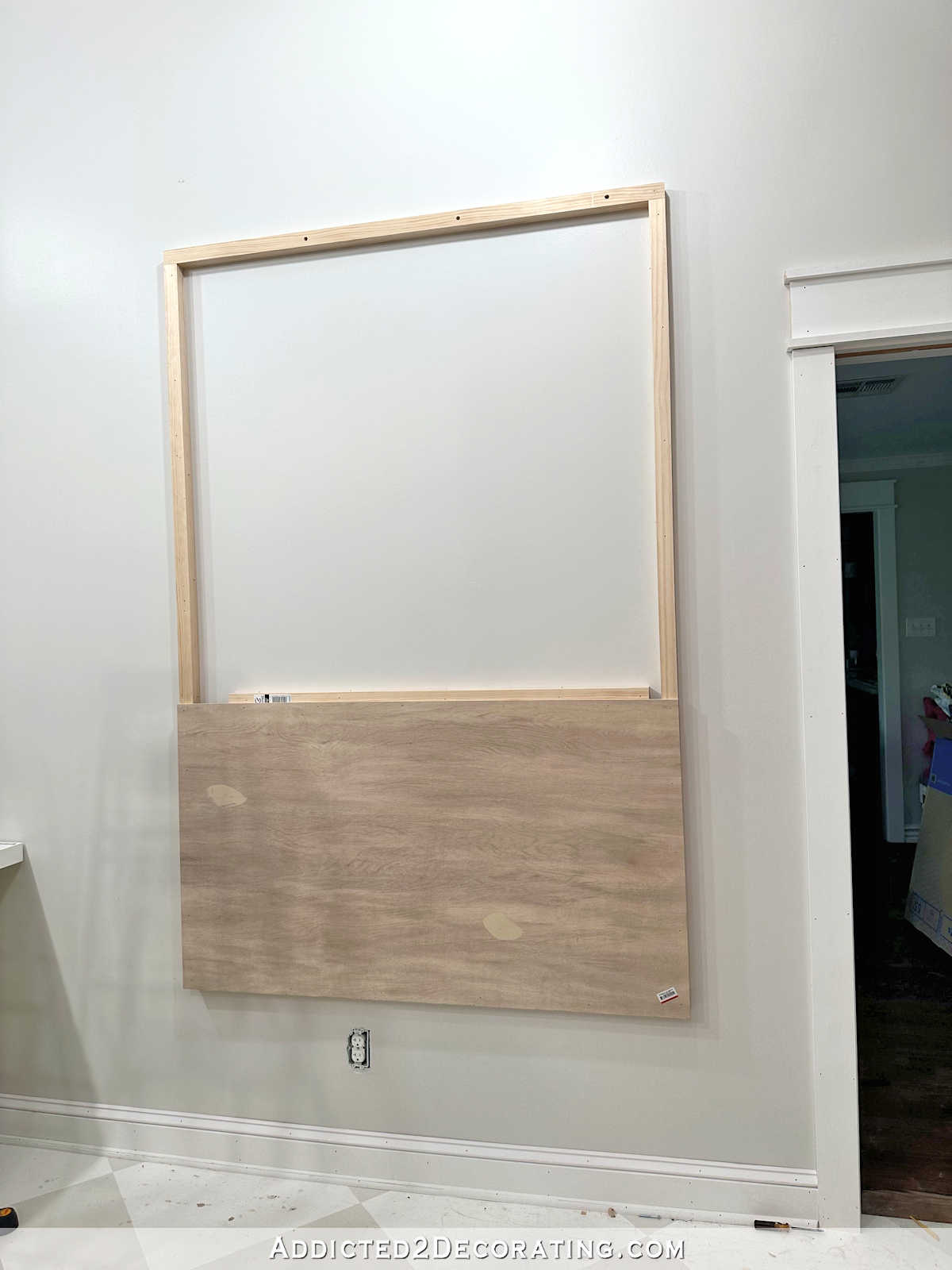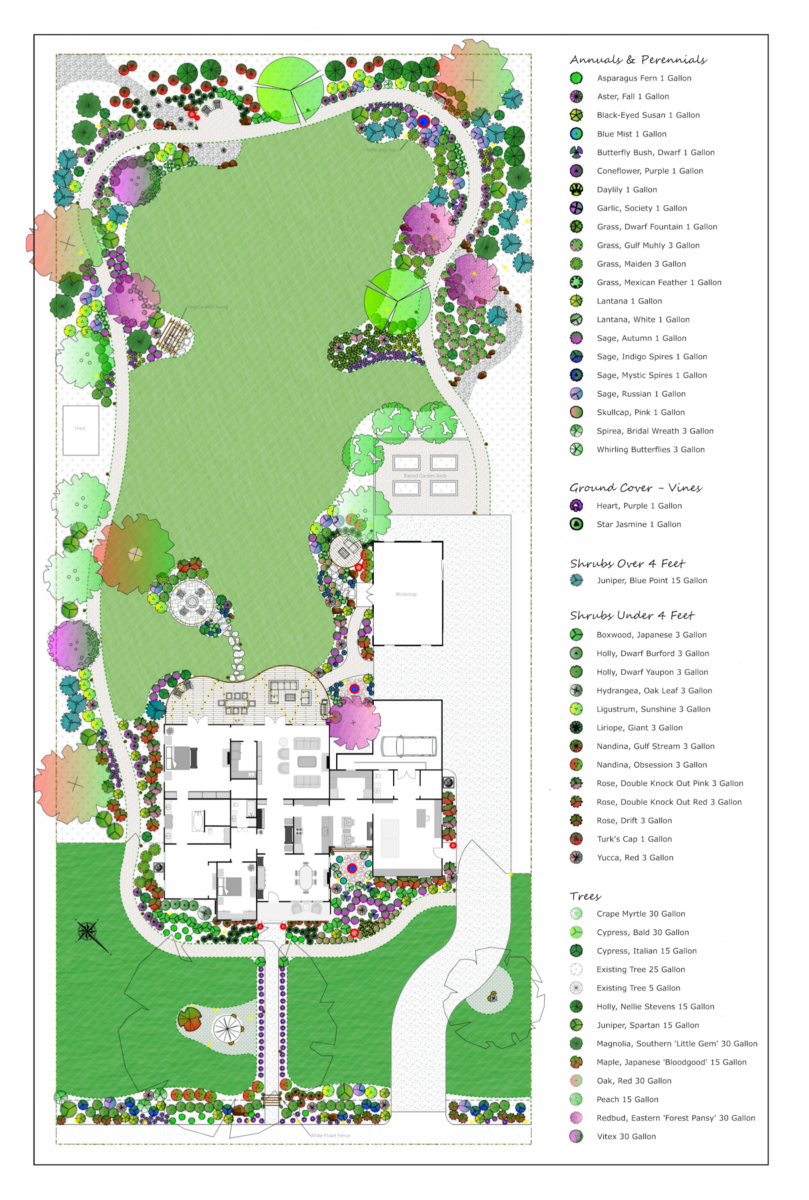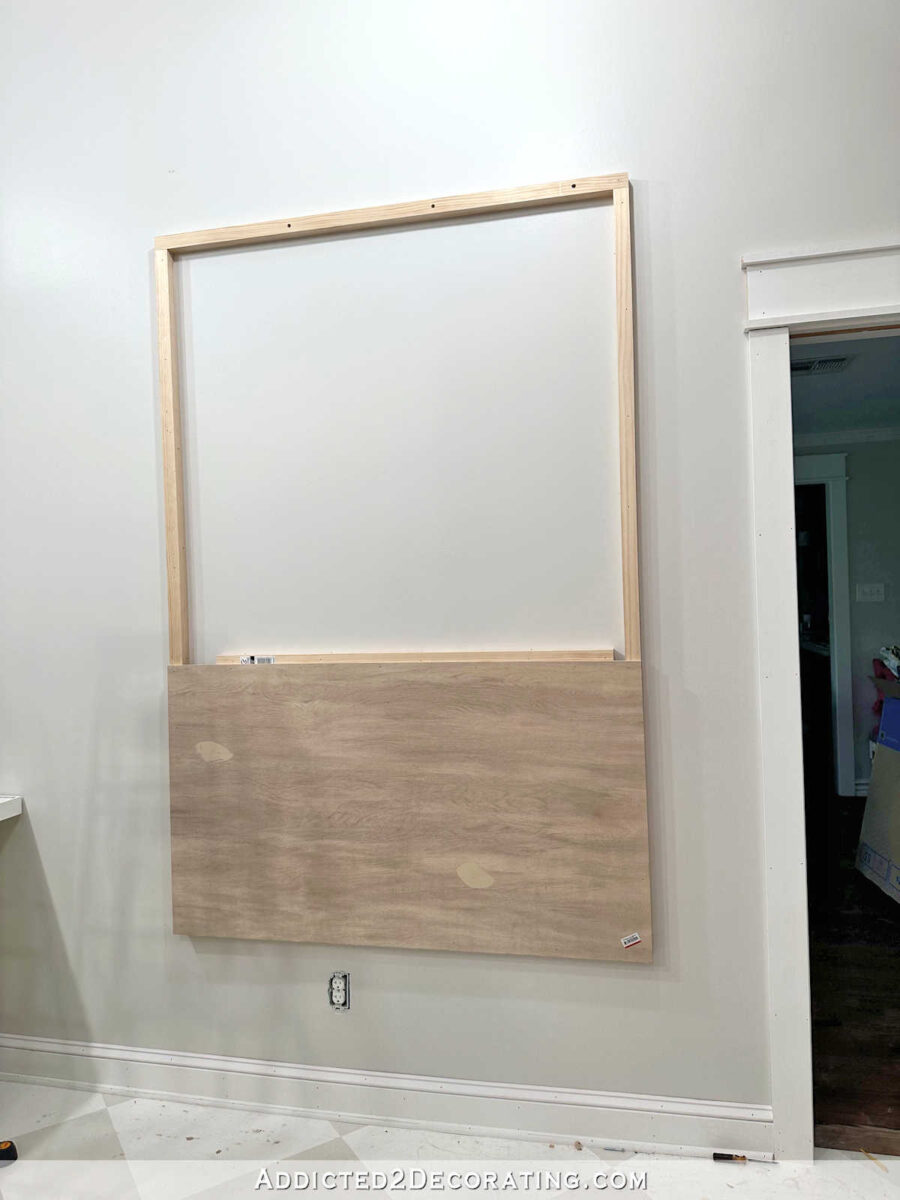
I advised y’all in a earlier publish about how a really variety and beneficiant reader provided to print my panorama design plan for me, and she or he had the aptitude of printing it HUGE. So I took her up on her very beneficiant supply and had the panorama design printed 52″W x 78″H. I want y’all may see this factor in individual as a result of it’s magnificent. But it surely additionally offered a dilemma. How on the earth was I going to mount and body a HUGE print like that?
In the event you’re new round right here, that is the panorama design I’m speaking about…

Matt (my husband) had purchased that panorama design for me about two years in the past. I met with a neighborhood panorama designer and advised him all of my needs and imaginative and prescient for our one acre lot, and that’s the design he got here up with. I believe it’s so fairly, so I’ve been eager to have it printed and grasp it on a wall ever since I noticed it the primary time.
With the print being so huge, I although the best factor could be to mount the print on plywood, after which body it and grasp it. Tremendous easy, proper? So a few days in the past, I headed to Residence Depot to select up a chunk of plywood for this mission, and it wasn’t till I had parked and was getting out of the automobile that it dawned on me…this factor is 52″ x 78″!! A bit of plywood is just 48″ extensive!
So then I needed to cease and rethink my plan. What I got here up with was a plan to principally construct an enormous cradle wooden panel, which is precisely what I used to mount my little resin petri discs on. It’s principally a body of wooden with a strong piece of plywood or MDF hooked up to the highest to create a wooden canvas.


Besides that as a substitute of it being a tiny 5″ x 5″, I wanted it to be about 150 instances that dimension. 😀
And since I all the time work alone, one other consideration I needed to work via was whether or not or not I’d be capable to construct this huge cradle wooden panel after which mount it on the wall on my own. Since I’m solely 5 toes tall, which signifies that my arm span from fingertip to fingertip is 5 toes, I critically doubted my skill to raise a 52″ x 78″ cradle wooden panel off the ground and hoist it onto no matter hanger I made a decision to make use of. So as a substitute, I made a decision to construct the cradle wooden panel instantly on the wall.
I began by utilizing my stage, framing sq., straight edge (i.e., a chunk of additional lumber), and a pencil to mark off the position of the underside proper nook. I want that I may have constructed this simply above the baseboard, however as you may see, I needed to clear {the electrical} outlet.


Subsequent, I used a stud finder to mark the position of the wall studs alongside the underside horizontal line.


I reduce a chunk of two″ x 2″ lumber to 52″ extensive, after which used the wall markings to mark the position of the studs on the lumber. I pre-drilled screw holes, after which used my largest bit to drill about 1/2-inch into the lumber in order that I may countersink my screws, and in order that they might be lengthy sufficient to enter the studs.


I hooked up that horizontal board to the wall alongside the marked line utilizing 2.5-inch screws. I used my stage to double test that the road was stage.


Subsequent, I reduce and hooked up the vertical 2″ x 2″ items. I didn’t screw these to the wall, and I didn’t be certain that they had been in studs. For the reason that weight of those items will likely be held by the underside horizontal piece, I solely wanted to make certain that these items had been firmly hooked up to the wall and to the underside piece. I began by utilizing my nail gun and 2-inch 16-gauge nails to nail via the underside horizontal piece and into the top of the vertical items. I used three nails on all sides.


With these items hooked up to one another, I then used my framing sq. to ensure the vertical items had been completely sq. with the underside piece, after which nailed the vertical piece on the precise to the wall utilizing those self same 2-inch 16-gauge nails.


Subsequent, I hooked up the highest piece. This one was screwed into studs identical to the underside piece, and it was additionally nailed to the vertical piece identical to I did on the underside corners.


After which lastly, I completed up by nailing the left vertical piece to the wall and to the highest horizontal piece.


To be sure that the vertical items stayed firmly towards the wall, I additionally went again and added nails going diagonally from the within fringe of the wooden and into the wall. The aim of that’s to create rigidity. With the nails going via the entrance of the wooden and straight into the wall, and the nails going diagonally from the within fringe of the wooden and into the wall, these vertical items received’t draw back from the wall.


And once more, the vertical items don’t actually have to hold weight as a result of the load is resting on the underside piece, which is screwed into studs, and the highest piece can also be screwed into studs in order that it received’t draw back from the wall.


For the face of the cradle wooden panel, I had to make use of two items of plywood as a result of, once more, plywood is just 48 inches extensive and this panel is 52 inches extensive. So I needed so as to add a chunk of lumber horizontally the place the 2 items of plywood would meet in order that I may nail the sides of the plywood to this piece. I didn’t need to buy one other piece for this, so I simply used a scrap, which was just some inches shy of the entire width. That’s not an issue so long as it’s also firmly hooked up to the wall. So I hooked up it in the identical means because the vertical items, with nails going instantly via the entrance into the wall, and the nails going diagonally via the highest and backside edges and into the wall.


Then I used to be prepared to connect the primary piece of plywood. I began with the little piece in order that I may extra simply maintain it into place whereas nailing it to the wooden body.


After which I did the larger piece on prime in order that I may relaxation the load of the larger piece on the underside piece whereas I nailed it into place.


You’ll discover that there’s a niche between the items that will get larger in direction of the precise aspect. I had checked and double checked my body to make sure the corners had been completely sq., so when the second piece of plywood didn’t line up completely with the body, I knew the problem was the plywood. So I needed to straighten it out across the edges, which created that hole between the 2 items. Issues like that may occur (and have occurred to me many instances) once I let Residence Depot or Lowe’s reduce my plywood for me.
I wasn’t fairly certain what to do about that hole. Would it not present via the print? Would it not create an unpleasant ripple? I bought the print out and tacked it to the panel to find out easy methods to proceed.


This paper is tremendous thick, however I may nonetheless see a distinction in colour at that hole. And I do plan to color the entire panel white earlier than mounting the print, so leaving the hole wasn’t actually an choice.


So then I needed to resolve easy methods to fill the hole. Caulk didn’t appear to be an excellent choice. I wanted one thing that might be sanded clean. However wooden filler didn’t appear to be an affordable choice as a result of the hole was too extensive. That a lot wooden filler wouldn’t solely take without end to dry, however would undoubtedly crack, requiring a number of coats and lots of hours of ready.
The choice I believed was the most effective was to make use of drywall tape and dirt.


In order that’s the place I left the mission. It can most likely want not less than another coat of drywall mud after I sand what’s there. (I’m not good in any respect with drywall mud.) After which I’ll prime and paint the panel, then mount the print, after which body the entire thing.


After all, I may have simply opted to connect the print on to the wall, after which use image body molding to border it. I got here very near doing that, however in the long run, I simply felt like that wouldn’t give the print the prominence it deserves. It will make it look extra like wallpaper than a separate piece of framed artwork. And I believe this undoubtedly deserves to be a separate piece of framed artwork, so ensuring that it tasks from the wall two inches will make it appear to be it’s mounted on a gallery wrapped canvas. This print deserves that.
Addicted 2 Adorning is the place I share my DIY and adorning journey as I rework and enhance the 1948 fixer higher that my husband, Matt, and I purchased in 2013. Matt has M.S. and is unable to do bodily work, so I do nearly all of the work on the home on my own. You can learn more about me here.







